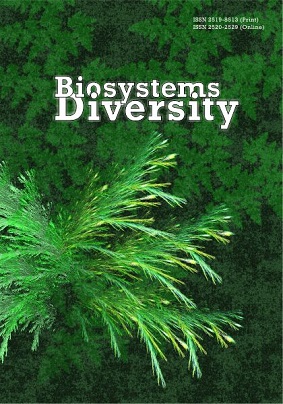Population systems of Eurasian water frogs (Pelophylax) in the south of Ukraine
Population systems of Eurasian water frogs (Pelophylax) in the south of Ukraine
Author(s): N. M. Suriadna, G. I. Mykytynets, M. Pupiņš, V. Y. GassoSubject(s): Energy and Environmental Studies, Human Ecology, Sociobiology, Environmental interactions
Published by: Дніпропетровський національний університет імені Олеся Гончара
Keywords: anurans; Pelophylax esculentus complex; hybrid speciation; semi-clonal reproduction; polyploidization; sex structure; habitat fidelity; species abundance;
Summary/Abstract: Ecological and evolutionary consequences of population-genetic processes that occur because of natural cross-species hybridization can show mechanisms of overcoming the reproductive barrier and obtaining the species status by a hybrid taxon. This is clearly seen in the population systems of Eurasian water frogs – Pelophylax esculentus complex. The P. esculentus(E) hybrid usually discards one of the parental genomes of P. lessonae (L) or P. ridibundus (R) and reproduces semi-clonally. The genetic structure and direction of gene flows precisely depend on the type and distribution of mixed or pure population systems of water frogs. Three population systems in the south of Ukraine were identified and confirmed as RR, RE and REL. The populations of P. ridibundus are most common (76.2%). A mixed population systems of P. ridibundus and P. esculentus (20.0%) are concentrated in the floodplains of large rivers where triploids were found and the unisexual hybrids (1.0♂ : 0.1♀) were proved. Parent species populations having different ploidy of P. esculentussuch as 3n and for the first time 4n were found. A mixed system of three taxa (REL) is rare (3.8%) and locally concentrated in the lower Danube and Dnieper with the smallest proportion of P. lessonae. We did not find populations of P. lessonae (LL), P. esculentus (EE, very rare system of hybrids only), and two mixed populations of parental species RL and semi-clonal LE in the south of Ukraine, but they are known for northern areas. The high number of P. ridibundustends to decrease; the scarce P. esculentus and the extremely rare P. lessonae require special conservation measures. P. ridibundus (RR) occupies a wide range of diverse natural, permanent, temporary, coastal, continental, and artificial freshwater bodies, including synanthropic ecosystems. Mixed population systems inhabit willow and poplar forests in the floodplains of large rivers. In the south of Ukraine rare and isolated populations of the water frogs occurring outside the main range can be relict. Biotopic preferences, ratio and number of constituent taxa are crucial for an adequate assessment of biological (taxonomic) diversity and development of an appropriate strategy for the population systems’ conservation. Such characteristics as unisexuality of hybrids, their spreading patterns, specific sex structure and ploidy in different population systems of the P. esculentus complex contribute to the understanding of the hybridogenetic dynamics; produce new tendencies of becoming independent hybridogenous taxa and emergence of new evolutionary relationships.
Journal: Biosystems Diversity
- Issue Year: 28/2020
- Issue No: 2
- Page Range: 154-162
- Page Count: 9
- Language: English

